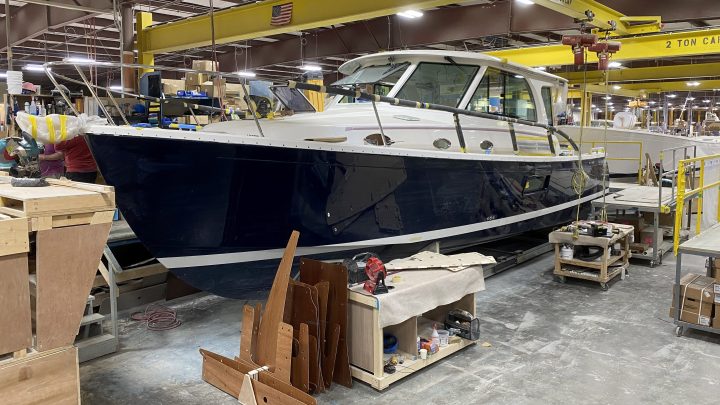
Boat builders struggle to meet soaring demand, solve supply chain woes
Boat builders struggle to meet soaring demand, solve supply chain woes

There’s been rising interest in outdoor recreation from people looking for pandemic-safe activities, and that demand is driving skyrocketing consumer sales in the boating industry.
Boat sales leaped to a 13-year-high in 2020, and the National Marine Manufacturers Association expects the boom to continue through 2021. U.S. sales of boats, marine products and services are estimated to have reached $47 billion in 2020, up 9% from the previous year.
Jason Constantine is president and chief operating officer of Back Cove Yachts, a boat manufacturing company in Rockland, Maine. Constantine said his shop is struggling to keep up with soaring demand because of supply chain delays and labor shortages, resulting in order backlogs into 2023.
“It’s been wonderful that the demand is there. But we really are approaching two years out in some instances,” Constantine said.
He spoke to “Marketplace” host Kai Ryssdal about the challenges of his business. The following is an edited transcript of their conversation.
Kai Ryssdal: How is business at Back Cove Yachts there in Rockland, Maine?
Jason Constantine: Business is wonderful these days. We are seeing an incredible demand in all boats sales throughout the industry, which certainly was born out of, I think, the free time folks have been granted because of this pandemic. At the same time, however, it’s created lots of challenges for us as a manufacturer, and I think it’s something all manufacturers are dealing with today.
Ryssdal: Well, let’s run through those challenges in a minute. But who is buying boats? Do you have, like, newbies coming in and doing it for the first time as a result of the pandemic? Are people upgrading their existing boats? What’s the demographic of your consumers?
Constantine: We’re not seeing the newbies, as you say, quite so much in our segment of the market. But throughout the industry, we are certainly seeing a lot of new folks getting involved. So we’re seeing the impact all the way through.
Ryssdal: That makes sense. Am I gonna have to take out a second mortgage to buy one of these things?
Constantine: Perhaps.
Ryssdal: That’s all right. Truth in advertising.
Constantine: Absolutely, yeah. Basically, anywhere from $500,000 up to probably about $800,000.
Ryssdal: So it’s an investment. Talk to me about the challenges, right, because it occurred to me as I was getting ready for this interview, this is fundamentally a manufacturing story, right? It’s American manufacturing, and manufacturing depends on supply chains. And as we have been hearing throughout this pandemic, supply chains almost everywhere are stressed.
Constantine: Yes, stressed beyond anything that I’ve seen in the 18 years I’ve been in this industry. It’s remarkable that we’ve really had, I feel, like a perfect storm of supply chain challenges. You know, we’ve heard shipping containers being in the wrong places around the world, and is, you know, obviously caused challenges around the ports. We had the snowstorm in Texas, where the bulk of our chemical manufacturing and processing plants take place. So all of our plastic bases and petroleum-based products, along with obviously natural gas and things like that that are required to make the fiberglass. And yes, throw in one of the largest container ships on the planet wedged in the Suez Canal, and we’ve really got quite a, quite a challenge with our supply chain.
Ryssdal: I laughed, but did you actually feel that Suez Canal backup?
Constantine: Not yet. We will. I think how dependent we are and how interconnected we are on this supply chain around the globe has a rippling effect that takes a fair amount of time. So we’re going to be feeling, you know, challenges in the supply chain for the foreseeable future.
Ryssdal: Talk to me about foreseeable future. I mean, if I order a boat today, how long do I have to wait to get it from you?
Constantine: We’re looking at 2023 right now. Yeah, no, it’s been wonderful that the demand is there. But we really are approaching two years out in some instances.
Ryssdal: Could you not just hire more people and build boats faster?
Constantine: That would be the easy and obvious thing to do, yes. However, the labor market isn’t any stronger than the supply chain at this point. I mean, from a manufacturing perspective, you know, we had our struggles with the labor market. And that was only been, you know, exaggerated by the pandemic. We hear stories of folks, you know, not being able to find work, but you can’t go anywhere around town here and not find a Help Wanted sign.
Ryssdal: Last thing, and then I’ll let you go. What do you estimate is going to be the timeframe to some kind of return to normal for you? I mean, I can’t imagine it’s normal for you to have two-year backlogs.
Constantine: No, it’s not. This is a challenge. I think we’re going to be certainly throughout 2021 trying to work our way back. I hope this is going to be that moment of awakening, I guess, for a bit of a manufacturing renaissance in this country.
There’s a lot happening in the world. Through it all, Marketplace is here for you.
You rely on Marketplace to break down the world’s events and tell you how it affects you in a fact-based, approachable way. We rely on your financial support to keep making that possible.
Your donation today powers the independent journalism that you rely on. For just $5/month, you can help sustain Marketplace so we can keep reporting on the things that matter to you.











